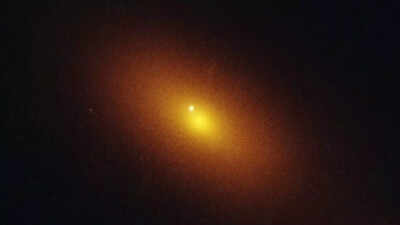
NASA has released a remarkable image of a black hole swallowing a star, revealing the dramatic final moments of a celestial body that ventured too close to one of the universe's most mysterious objects. The event, known as a
Tidal Disruption Event
(TDE), occurred 600 million light-years away but has only just become visible to Earth-based telescopes. The image, captured by the
Hubble Space Telescope
and confirmed with data from the Chandra X-ray Observatory and the Very Large Array radio telescope, shows a bright burst of radiation marking the violent death of the star.
This rare cosmic spectacle not only provides a glimpse into the extreme environments around black holes but also opens new avenues for understanding these enigmatic cosmic giants.
What is a Tidal Disruption Event (TDE)
A Tidal Disruption Event occurs when a star passes too close to a supermassive black hole, crossing the critical distance known as the "tidal radius." At this point, the immense gravitational pull of the black hole overwhelms the star’s self-gravity, pulling it apart in a process known as "spaghettification." This extreme stretching shreds the star into long, thin streams of gas that spiral around the black hole, forming an accretion disk. The intense gravitational forces and friction within this disk heat the stellar debris to millions of degrees, creating powerful bursts of light, X-rays, and other high-energy radiation that can be detected by Earth-based and space-based telescopes.
NASA’s Hubble captures rare black hole event 600 million light-years away
The recent TDE, labeled AT2024tvd, was detected as a bright, off-center dot in an image taken by the Hubble Space Telescope. NASA shared this striking image on social media, capturing the attention of astronomers and space enthusiasts worldwide. The event took place 600 million light-years away, but the light from this catastrophic incident has only now reached Earth, revealing the violent end of the star.Lead study author Yuhan Yao of the University of California, Berkeley, described AT2024tvd as the first "offset" TDE captured by optical sky surveys, indicating that the black hole involved is likely a wandering black hole, not anchored to the center of a galaxy. This rare observation could reshape current theories about black hole behavior. Yao noted, "AT2024tvd is the first offset TDE captured by optical sky surveys, and it opens up the entire possibility of uncovering this elusive population of
wandering black holes
with future sky surveys."
Observing the cosmic event
NASA’s Hubble Space Telescope provided the initial image, while follow-up observations from the Chandra X-ray Observatory and the Very Large Array (VLA) radio telescope confirmed the nature of the event. These powerful observatories captured the high-energy radiation produced as the star was shredded and consumed by the black hole, providing a multi-wavelength view of the destruction.This comprehensive approach to observing TDEs allows astronomers to study the complex physical processes involved, from the initial tidal disruption to the subsequent formation of the accretion disk and the powerful jets that can sometimes emerge from these violent encounters.
Why TDEs are scientifically significant
Tidal Disruption Events are valuable to astronomers because they provide a unique way to detect and study black holes, which are otherwise invisible due to their light-absorbing nature. TDEs reveal the presence of black holes through the intense radiation produced as they consume nearby stars, offering insights into their masses, spin rates, and feeding habits.Ryan Chornock, an associate adjunct professor at UC Berkeley and a member of the ZTF (Zwicky Transient Facility) team, highlighted this importance, stating, "Tidal disruption events hold great promise for illuminating the presence of massive black holes that we would otherwise not be able to detect."Additionally, TDEs can provide valuable information about the distribution and behavior of stars within galaxies, helping scientists understand the dynamic environments surrounding black holes and the complex interactions that lead to these catastrophic events.
Offset TDEs and their implications
The AT2024tvd observation is particularly significant because it is classified as an "offset" TDE, meaning it likely originated from a black hole that is not located at the center of a galaxy. These wandering black holes are believed to be the remnants of past galaxy mergers, which can dislodge
supermassive black holes
from their central positions.Yao emphasised the importance of this discovery, noting that it could motivate further searches for similar offset TDEs in future sky surveys, potentially revealing a previously hidden population of black holes that move through intergalactic space.
Future research and observations
This discovery marks an important step in expanding our understanding of black holes and the extreme environments they create. With advancements in telescope technology and ongoing sky surveys, astronomers expect to detect more TDEs in the coming years, providing deeper insights into the life cycles of stars and the hidden population of wandering black holes.The ongoing work by researchers like Yao and Chornock, combined with data from next-generation observatories like the James Webb Space Telescope (JWST) and Vera C. Rubin Observatory, promises to unlock even more mysteries of the universe, potentially revealing new aspects of black hole behavior and their impact on the evolution of galaxies.

 1 month ago
157
1 month ago
157




























 English (US)
English (US)